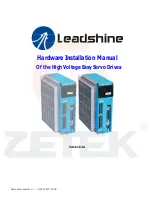
7-22 Process CL Feedback 2 Resource
Option:
Function:
[4]
Frequency input
33
4.8.4 7-3* Process PID Ctrl.
7-30 Process PID Normal/ Inverse Control
Option:
Function:
Normal and inverse controls are implemented by
introducing a difference between the reference
signal and the feedback signal.
[0]
*
Normal Sets process control to increase the output
frequency.
[1]
Inverse Sets process control to decrease the output
frequency.
7-31 Process PID Anti Windup
Option: Function:
[0]
Off Continues regulation of an error even when the
output frequency cannot be increased or decreased.
[1]
*
On Ceases regulation of an error when the output
frequency can no longer be adjusted.
7-32 Process PID Start Speed
Range:
Function:
0 RPM
*
[0 -
6000
RPM]
Enter the motor speed to be attained as a
start signal for commencement of PID
control. When the power is switched on, the
frequency converter starts to ramp and then
operates under speed open-loop control.
When the process PID start speed is reached,
the frequency converter changes to process
PID control.
7-33 Process PID Proportional Gain
Range:
Function:
Size related
*
[0 - 10] Enter the PID proportional gain. The
proportional gain multiplies the error
between the setpoint and the feedback
signal.
7-34 Process PID Integral Time
Range:
Function:
9999 s
*
[0.10 -
9999 s]
Enter the PID integral time. The integrator
provides an increasing gain at a constant
error between the setpoint and the
feedback signal. The integral time is the
time needed by the integrator to reach the
same gain as the proportional gain.
7-35 Process PID Differentiation Time
Range:
Function:
0 s
*
[0 - 20 s] Enter the PID differentiation time. The differen-
tiator does not react to a constant error, but
provides a gain only when the error changes.
The shorter the PID differentiation time, the
stronger the gain from the differentiator.
7-36 Process PID Diff. Gain Limit
Range:
Function:
5
*
[1 - 50] Enter a limit for the differentiator gain. If there is
no limit, the differentiator gain increases when
there are fast changes. To obtain a pure differen-
tiator gain at slow changes and a constant
differentiator gain where fast changes occur, limit
the differentiator gain.
7-38 Process PID Feed Forward Factor
Range:
Function:
0 %
*
[0 -
200 %]
Enter the PID feed forward (FF) factor. The FF
factor sends a constant fraction of the reference
signal to bypass the PID control, so the PID
control only affects the remaining fraction of the
control signal. Any change to this parameter
affects the motor speed. When the FF factor is
activated, it provides less overshoot, and high
dynamics when changing the setpoint.
Parameter 7-38 Process PID Feed Forward Factor
is
active when
parameter 1-00 Configuration Mode
is set to
[3] Process
.
7-39 On Reference Bandwidth
Range:
Function:
5 %
*
[0 -
200 %]
Enter the on-reference bandwidth. When the
PID control error (the difference between the
reference and the feedback) is less than the
value of this parameter, the on-reference
status bit is 1.
4.8.5 7-4* Advanced Process PID Ctrl.
This parameter group is only used if
parameter 1-00 Config-
uration Mode
is set to
[7] Extended PID speed CL
.
7-40 Process PID I-part Reset
Option: Function:
[0]
*
No
[1]
Yes Select
[1] Yes
to reset the I-part of the process PID
controller. The selection automatically returns to
[0]
No
. Resetting the I-part makes it possible to start from
a well-defined point after changing something in the
process, for example changing a textile roll.
Parameter Descriptions
VLT
®
AutomationDrive FC 360
70
Danfoss A/S © 7/2015 All rights reserved.
MG06C602
4
4
















































